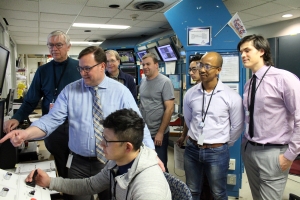Accelerator-based method of 99Mo production The first foreign internship of a RadFarm PhD student
25-03-2020
Tobiasz Zawistowski MSc, a student of the RadFarm interdisciplinary doctorate studies, was an intern at CANADIAN ISOTOPE INNOVATIONS Corp. (CII) (http://isotopeinnovations.com/) and carried out experiments at Canadian Light Source (CLS) (https://www.lightsource.ca/).
„Mr. Mark de Jong - Chief Technology Officer at Canadian Isotope Innovations Corp. was the supervisor of my internship” Tobiasz Zawistowski MSc says. „I met Mark in May 2019 during the 2nd Research Coordination Meeting on “New Ways of Producing 99mTc and 99mTc Generators” coordinated by POLATOM and organized in NCBJ. He mentioned that his team had been researching the accelerator-based method of 99Mo production for the past several years.”
Molybdenum-99, which undergoes nuclear decay to technetium-99m, is the main isotope used in nuclear medicine. It is obtained primarily in nuclear reactors, such as the Polish research reactor MARIA at National Center for Nuclear Research (NCBJ) in Otwock-Świerk. However the method of producing this isotope based on nuclear reactors has significant limitations, hence scientists continue to search for new methods to produce efficiently molybdenum-99, for example, using accelerators. This issue is also being explored by a PhD student, Tobiasz Zawistowski MSc, who is building an experimental station at NCBJ for producing the 99Mo with an electron beam from a linear accelerator. "The nuclear reaction leading to molybdenum-99 production is crucial in my doctoral study. The Molybdenum-100 nucleus emits a neutron when a high-energy photon hits the target," says the PhD student. "The photon beam necessary for this nuclear reaction is produced as a result of inhibition of accelerated electrons on the atomic nuclei of a conversion target made of e.g., tantalum or tungsten."
The internship, supported by RadFarm, allowed the Polish PhD student to participate in an experiment carried out at CLS as part of the IAEA project. NECSA researchers from South Africa (http://www.necsa.co.za/) were also involved in it. The PhD student will use the experience gained in conducting the actual molybdenum-99 production process while preparing his experimental stage of research at NCBJ. "In the experiment carried out at CLS, irradiation of the target containing molybdenum-100 took place in a linear electron accelerator with 35 MeV beam energy" explains Tobiasz Zawistowski MSc. "NCBJ is currently building an accelerator with 30 MeV beam Energy which is very similar to that available at CLS Laboratory. Mainly with the help of this Polish device I intend to perform an experimental part of my PhD thesis."
Mr. Tobiasz Zawistowski has very good memories of the time spent together with foreign colleagues: "Although the first week was marked by frost (the air temperature ranged from -20 to -35 degrees Celsius), it was really hot in the lab. Along with the Canadian scientists and colleagues from South Africa, I participated in an experiment exploring the possibility of obtaining high specific activity of molybdenum-99 in the containing material. The Canadian Light Source linear accelerator is located in the underground bunker. It is surrounded by tons of concrete, lead and polyethylene plates, protecting researchers from radiation."
The scientists are still working on the data obtained, so we have to wait a bit for the results to be published. However, the preliminary results of the research carried out by an international team indicate that the method used works and it will be possible to use it in the event of temporary reduction of production in reactors, which already took place in 2008. The accelerated molybdenum production method used on a larger scale may also be cheaper. It also generates less radioactive waste.
RadFarm project "Radiopharmaceuticals for molecularly targeted diagnostics and medical therapy", Agreement No. POWR.03.02.00-00-I009 / 17-00 under the Operational Program Knowledge Education Development 2014-2020 co-financed by the European Social Fund, is implemented in a consortium of four units, two research institutes, NCBJ and IChTJ, and two universities, UW and WUM.
The supervisors of Tobiasz Zawistowski’s PhD thesis (being prepared at NCBJ) are Sławomir Wronka, PhD, DSc (prof. NCBJ), Renata Mikołajczak, BEng, PhD, DSc (prof. NCBJ) and dr Izabela Cieszykowska.





